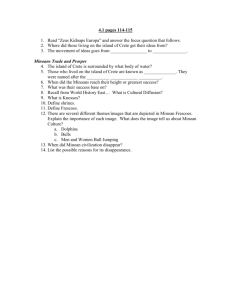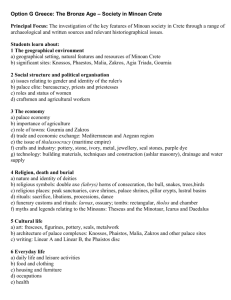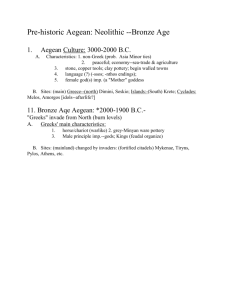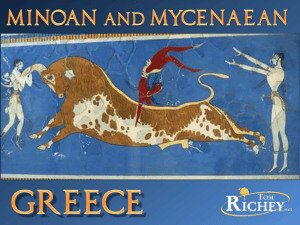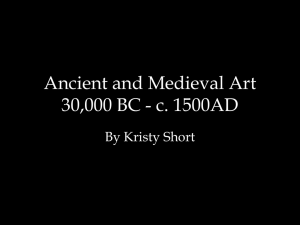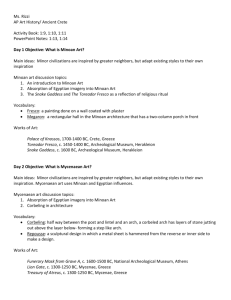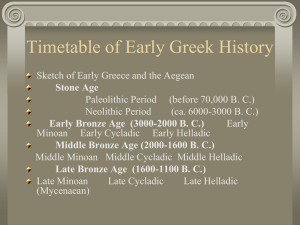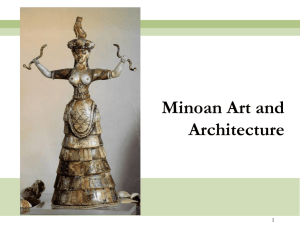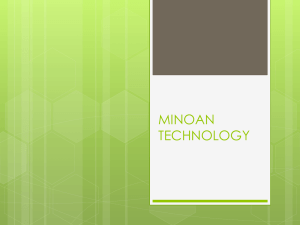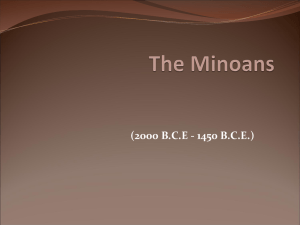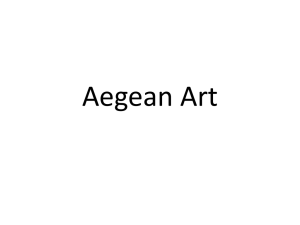MINOAN ART
advertisement
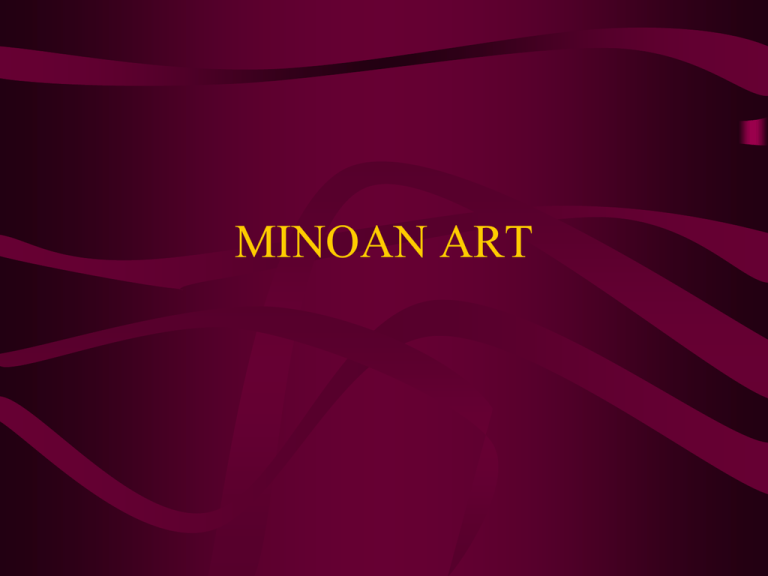
MINOAN ART MINOAN ART • Art in Crete reached its peak during the Neopalatial period, reflecting the period of extraordinary development. • During the postpalatial period it echoed the decline of Minoan civilisation. METAL WORK • Exquisite metal works were created in ancient Crete with gold and copper imported from abroad • They employed several techniques to shape various metals into objects. • They mastered the techniques of casting, embossing, gilding and faience. EVIDENCE OF MINOAN ART • Ornament in the shape of a crouching lion from the tomb of Ayia Triadha. • Probably LM1 c.15501450BC • Gold • Pendant from the Aigina treasure. • MMIII c.17001550BC • gold • Bee pendant • C.1800-1700BC • Gold • Gold ring with the depiction of a bull jumping scene from Phourni • Before 2000BC • Duckling ornament • 1500BC • A reconstruction of an old grape press (called galeagra) • 13th-15th century BC FRESCOES • • • • All frescoes are Neopalatial in date. Very few were found at Malia and Phaistos, Most are from Knossos and Agia Triadha. Most common themes in Knossos: – – – – Bull leaping Boxing and wrestling Heraldic Griffin compositions Processional scenes CLASSIFYING FRESCOES • Frescoes can be classified in the following broad terms: – – – – – – – Painted stucco relief frescoes Frescoes with human and animal representation Life size Under life size but not miniature Miniature Formal patterns or heraldic animals on a large scale Decorated floors CHARACTERISTICS OF MURAL PAINTING • Specific skin colour for the sexes: red for male white for female • Genre scenes are common, but there are no unmistakably particularised scenes, whether historical or mythical • Scenes from nature are realistic in terms of human or animal participants • Backgrounds in frescoes are often “fantastic”. Brightly coloured, no attempt at depth or scale • The range of colours is remarkably varied • Wide variety of scenes and individual motifs • No use of shading to indicate relief • Underwater scenes seem to have been restricted to floor decoration • Absence of hunting scenes and scenes of warfare. • “Dancing women in the Garden” • Miniature fresco from Knossos • LMII 1450BC • Spectators by a shrine • Miniature fresco from Knossos • LMII • The purple monkey fresco • Found at Knossos • MMIIIA 17001600BC • Part of the bull leaping fresco (Toreodor fresco) at Knossos • Restored panel • One of a series • Probably LMII c.1450BC SCULPTURE • Very little sculpture from Crete has survived since most of it was not monumental and instead consisted of small objects dedicated to Gods and kings. • Bull leaper figurine • Knossos • Ivory • Goddess with poppy headed pins • Terracotta • 1350BC • Bulls head ryton from the palace of Kato Zacro • 1700-1450BC • A snake goddess faience • 1600-1580BC • Bull from Phaistos • Terracotta • 1200BC • A sphinx from Malia • Molded clay • 2000-1550BC MINOAN POTTERY • The transition in periods in the Minoan society can be seen in the style and pattern of their pottery. • As each new ‘era’ emerged out of the dust of the last, a new phase of pottery began. • While some pottery is in short supply, some palaces, such as Knossos can provide the historian with a complete history of the pottery of Crete. • Beak spouted cup • 2200-2000BC POTTERY STYLES • LMIA – 1675-1600BC • Most popular shapes – straight sided cup, semiglobular cup, bridge spouted jar, beaked jug. • Most popular motifs – spiral and floral motifs. Ripple pattern. • LM1B 1600-1500BC • Marine style octopus, dolphin, seaweed, star • Conical shapes, stirrup jars, very few cups • Beaked jugs, figure of eight shields, double axe, rockwork • LMII 1500-1450BC • Goblets, horizontal handled bowl, krater • Trend away from naturalism towards abstraction. • LMIIIA 1450-1340BC • We see a standardisation of pottery suggesting that there is decrease in regionalism • Appearance of a plain or solid painted, short stemmed, one handed goblet. • LMIIIB 1340-1190BC • There is no discernable break between these two periods. • Historians often label things LMIIIA2/IIIB • The deep bowl begins to grow more popular during this period. • LMIIIC 11901125/1100BC • Again the transition between the periods is slight. • The deep bowl gains more prevalence. • The fringed style (lines on the outside of frescoes) becomes popular. • Krater with plastic decoration • Kamares style • 1800BC • Octopus vase • Marine style • LMI – 1500BC • • • • Harvester Vase From Hagia Triada C.1550-1500BC steatite • Clay seistrum • 2100-2000BC THE PHAISTOS DISC THE PHAISTOS DISC • It is the only example of its kind. • No other inscroptions bearing similar shaped signs has been found. • Found in Phaistos • Thougyht to date from c.1700BC – thus contemporary with Linear A • Because no other examples of this writing have been found anywhere in Crete it is thought the disc is foreign and brought in from another place. • The place of its origin is speculation – but it is thought to come from somewhere in Asia Minor – given some of the inscriptions. • Because there is no variation between different copies of the same symbol, it is very likely that stamps were used to create the signs.
